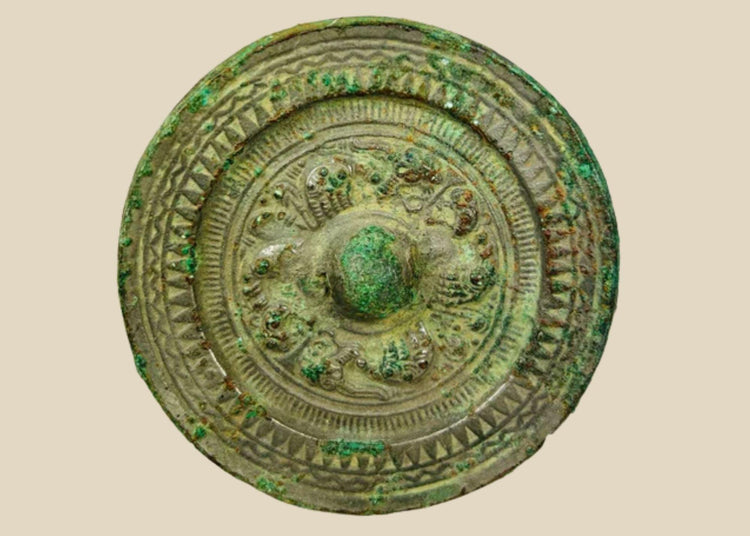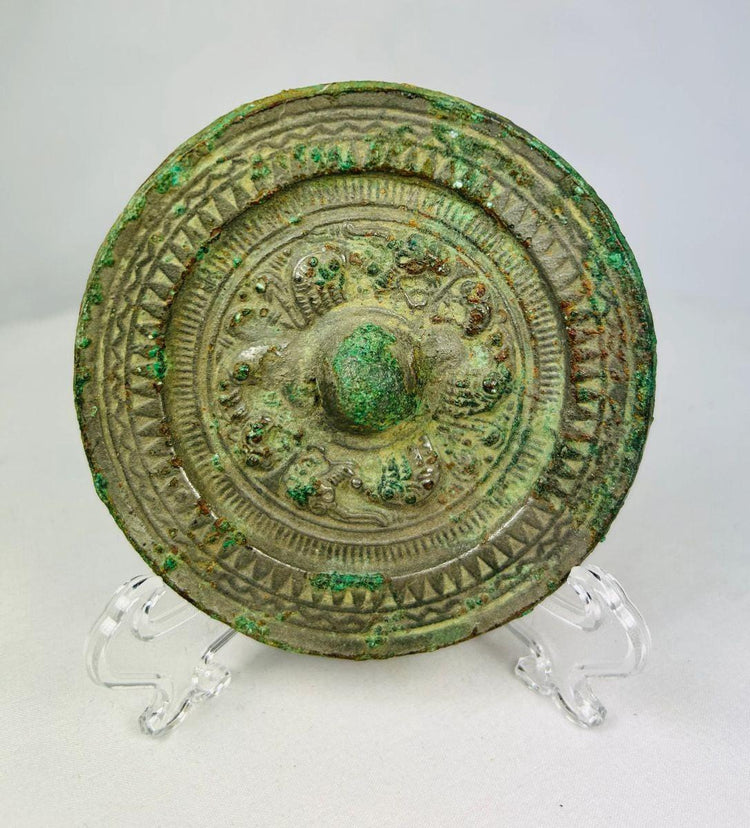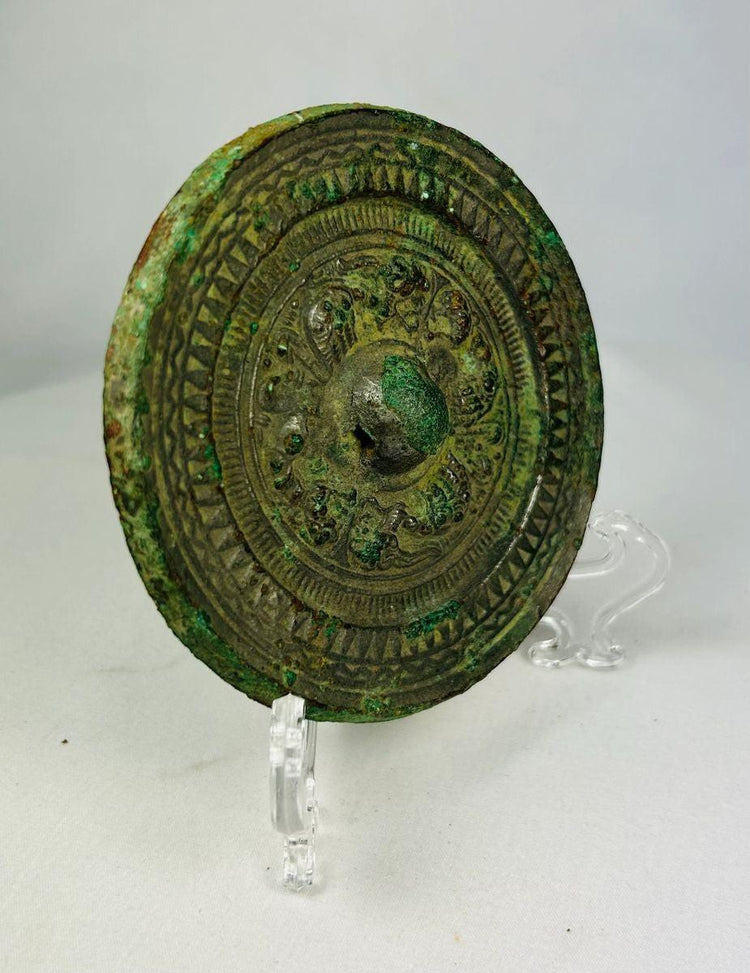Miroir en bronze | Chine ancienne | Dynastie Han | Vers 206 av. J.-C. – 220 apr. J.-C.
Description
Plus
Moins
Contexte historique et origine
Région : Chine ancienne
Matériau : Bronze coulé avec motifs géométriques et mythiques gravés
Période : Dynastie Han (206 avant notre ère – 220 après JC)
Description
Ce miroir en bronze finement moulé illustre le talent artistique et la richesse symbolique de l'artisanat de la dynastie Han. Utilisés par la noblesse et l'élite, les miroirs étaient prisés non seulement comme outils de toilette, mais aussi comme puissants objets spirituels censés éloigner le mal et refléter la pureté du corps et de l'esprit. Sa surface présente des motifs géométriques complexes et des motifs en relief, avec un bouton central percé pour la suspension ou l'attache d'un cordon de soie. Sa riche patine vieillie témoigne de siècles d'inhumation, confirmant à la fois son authenticité et sa signification rituelle. De tels miroirs en bronze étaient souvent enterrés dans des tombes, garantissant à leurs propriétaires beauté, statut et protection spirituelle dans l'au-delà.
Caractéristiques
- Conception finement moulée avec des motifs géométriques et mythiques
- Bouton central saillant avec trou pour fixation du cordon ou de la poignée
- Riche patine verte due à des siècles d'oxydation et d'enfouissement
- Décoration symbolique signifiant protection et bonne fortune
- Objet d'élite d'importance quotidienne et spirituelle
Importance culturelle
Sous la dynastie Han, les miroirs en bronze symbolisaient plus que le raffinement : ils incarnaient le pouvoir spirituel et le statut social. Considérés comme protecteurs contre les forces du mal, ils reflétaient également les idéaux confucéens et taoïstes de clarté et d'harmonie. Leur présence fréquente dans les sépultures de l'élite illustre leur rôle dans la prospérité et la beauté éternelles, tout en étant un gage de richesse et de sophistication.
Condition
Le miroir est en excellent état archéologique, avec une patine verte bien développée et de légères incrustations qui renforcent son authenticité. Les motifs décoratifs sont toujours visibles et le bouton central est intact, préservant ainsi sa forme et sa fonction d'origine.
Dimensions (approximatives)
Diamètre : 3,75 po
Âge
Plus de 1 800 ans
Description
Contexte historique et origine
Région : Chine ancienne
Matériau : Bronze coulé avec motifs géométriques et mythiques gravés
Période : Dynastie Han (206 avant notre ère – 220 après JC)
Description
Ce miroir en bronze finement moulé illustre le talent artistique et la richesse symbolique de l'artisanat de la dynastie Han. Utilisés par la noblesse et l'élite, les miroirs étaient prisés non seulement comme outils de toilette, mais aussi comme puissants objets spirituels censés éloigner le mal et refléter la pureté du corps et de l'esprit. Sa surface présente des motifs géométriques complexes et des motifs en relief, avec un bouton central percé pour la suspension ou l'attache d'un cordon de soie. Sa riche patine vieillie témoigne de siècles d'inhumation, confirmant à la fois son authenticité et sa signification rituelle. De tels miroirs en bronze étaient souvent enterrés dans des tombes, garantissant à leurs propriétaires beauté, statut et protection spirituelle dans l'au-delà.
Caractéristiques
- Conception finement moulée avec des motifs géométriques et mythiques
- Bouton central saillant avec trou pour fixation du cordon ou de la poignée
- Riche patine verte due à des siècles d'oxydation et d'enfouissement
- Décoration symbolique signifiant protection et bonne fortune
- Objet d'élite d'importance quotidienne et spirituelle
Importance culturelle
Sous la dynastie Han, les miroirs en bronze symbolisaient plus que le raffinement : ils incarnaient le pouvoir spirituel et le statut social. Considérés comme protecteurs contre les forces du mal, ils reflétaient également les idéaux confucéens et taoïstes de clarté et d'harmonie. Leur présence fréquente dans les sépultures de l'élite illustre leur rôle dans la prospérité et la beauté éternelles, tout en étant un gage de richesse et de sophistication.
Condition
Le miroir est en excellent état archéologique, avec une patine verte bien développée et de légères incrustations qui renforcent son authenticité. Les motifs décoratifs sont toujours visibles et le bouton central est intact, préservant ainsi sa forme et sa fonction d'origine.
Dimensions (approximatives)
Diamètre : 3,75 po
Âge
Plus de 1 800 ans
Vous aimerez peut-être aussi


































